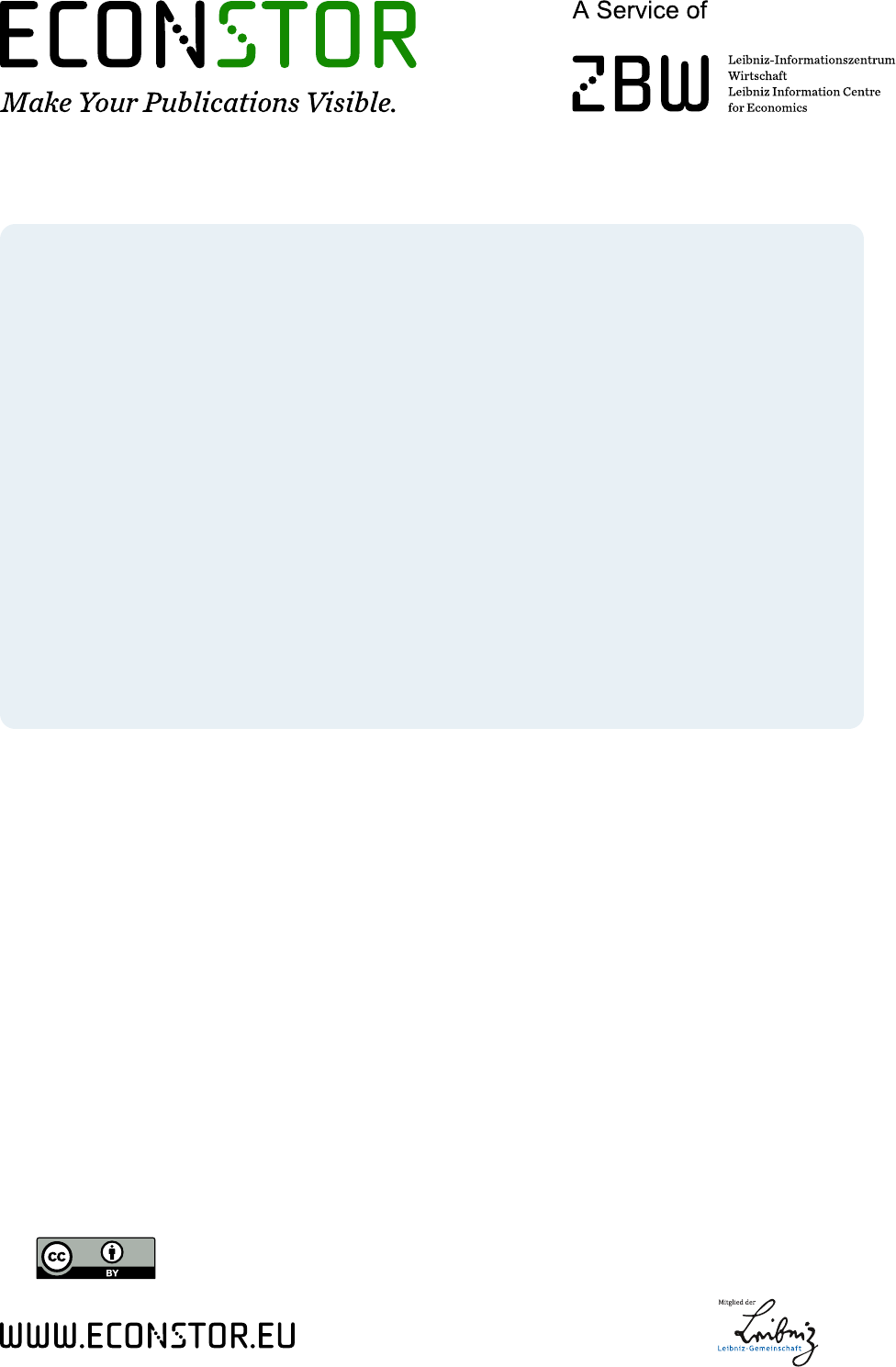
Thavorn, Jakkrit; Trichob, Puripat; Klongthong, Worasak; Ngamkroeckjoti, Chittipa
Article
Effect of mid-roll video advertising value and perceived intrusiveness
on Facebook viewers' response: the mediating roles of attitude and
word-of-mouth intention
Cogent Business & Management
Provided in Cooperation with:
Taylor & Francis Group
Suggested Citation: Thavorn, Jakkrit; Trichob, Puripat; Klongthong, Worasak; Ngamkroeckjoti,
Chittipa (2022) : Effect of mid-roll video advertising value and perceived intrusiveness on Facebook
viewers' response: the mediating roles of attitude and word-of-mouth intention, Cogent Business &
Management, ISSN 2331-1975, Taylor & Francis, Abingdon, Vol. 9, Iss. 1, pp. 1-22,
https://doi.org/10.1080/23311975.2022.2062091
This Version is available at:
https://hdl.handle.net/10419/288703
Standard-Nutzungsbedingungen:
Die Dokumente auf EconStor dürfen zu eigenen wissenschaftlichen
Zwecken und zum Privatgebrauch gespeichert und kopiert werden.
Sie dürfen die Dokumente nicht für öffentliche oder kommerzielle
Zwecke vervielfältigen, öffentlich ausstellen, öffentlich zugänglich
machen, vertreiben oder anderweitig nutzen.
Sofern die Verfasser die Dokumente unter Open-Content-Lizenzen
(insbesondere CC-Lizenzen) zur Verfügung gestellt haben sollten,
gelten abweichend von diesen Nutzungsbedingungen die in der dort
genannten Lizenz gewährten Nutzungsrechte.
Terms of use:
Documents in EconStor may be saved and copied for your personal
and scholarly purposes.
You are not to copy documents for public or commercial purposes, to
exhibit the documents publicly, to make them publicly available on the
internet, or to distribute or otherwise use the documents in public.
If the documents have been made available under an Open Content
Licence (especially Creative Commons Licences), you may exercise
further usage rights as specified in the indicated licence.
https://creativecommons.org/licenses/by/4.0/
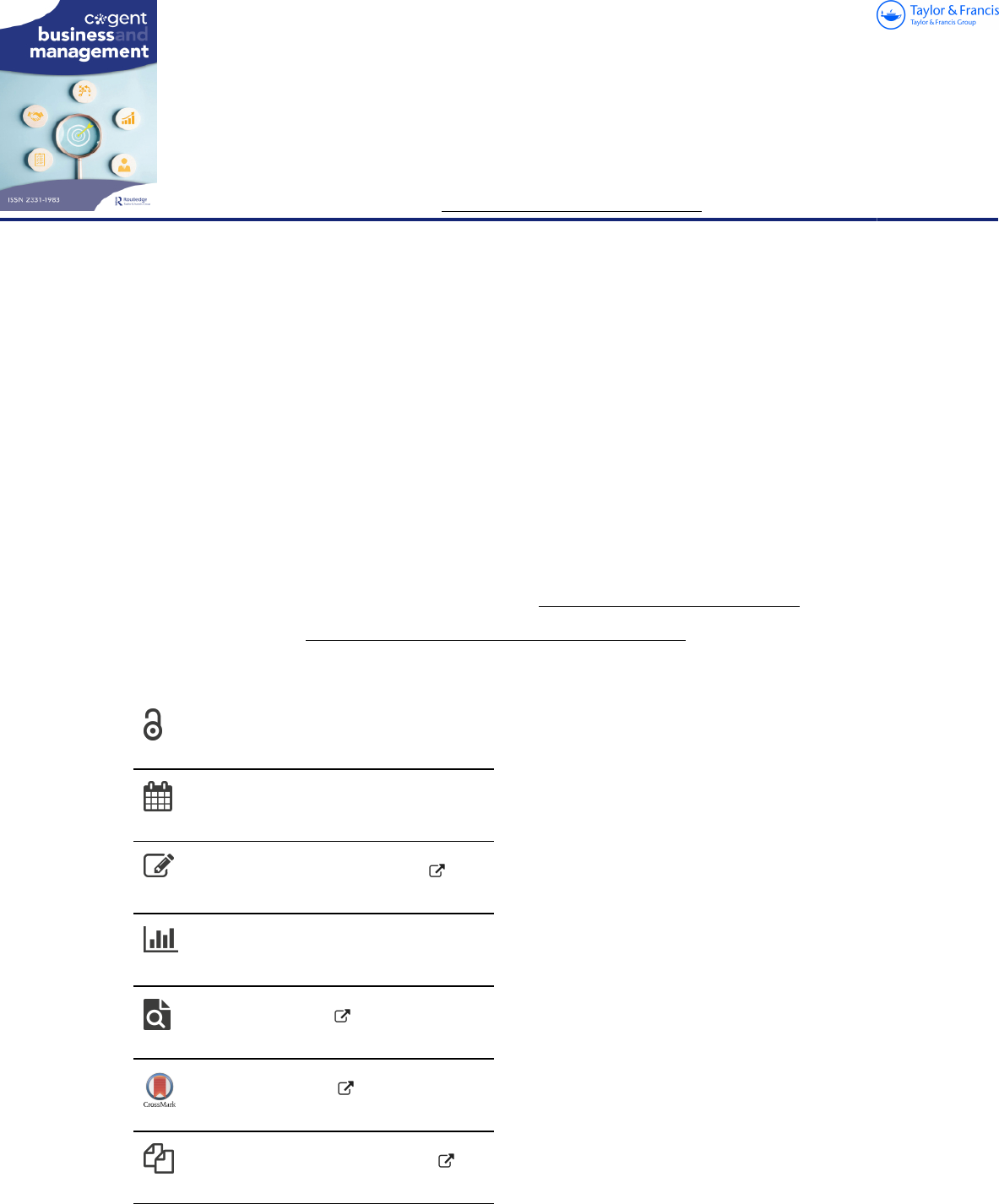
Full Terms & Conditions of access and use can be found at
https://www.tandfonline.com/action/journalInformation?journalCode=oabm20
Cogent Business & Management
ISSN: (Print) (Online) Journal homepage: www.tandfonline.com/journals/oabm20
Effect of mid-roll video advertising value and
perceived intrusiveness on Facebook viewers’
response: the mediating roles of attitude and
word-of-mouth intention
Jakkrit Thavorn, Puripat Trichob, Worasak Klongthong & Chittipa
Ngamkroeckjoti
To cite this article: Jakkrit Thavorn, Puripat Trichob, Worasak Klongthong & Chittipa
Ngamkroeckjoti (2022) Effect of mid-roll video advertising value and perceived intrusiveness
on Facebook viewers’ response: the mediating roles of attitude and word-of-mouth intention,
Cogent Business & Management, 9:1, 2062091, DOI: 10.1080/23311975.2022.2062091
To link to this article: https://doi.org/10.1080/23311975.2022.2062091
© 2022 The Author(s). This open access
article is distributed under a Creative
Commons Attribution (CC-BY) 4.0 license.
Published online: 19 Apr 2022.
Submit your article to this journal
Article views: 3286
View related articles
View Crossmark data
Citing articles: 3 View citing articles
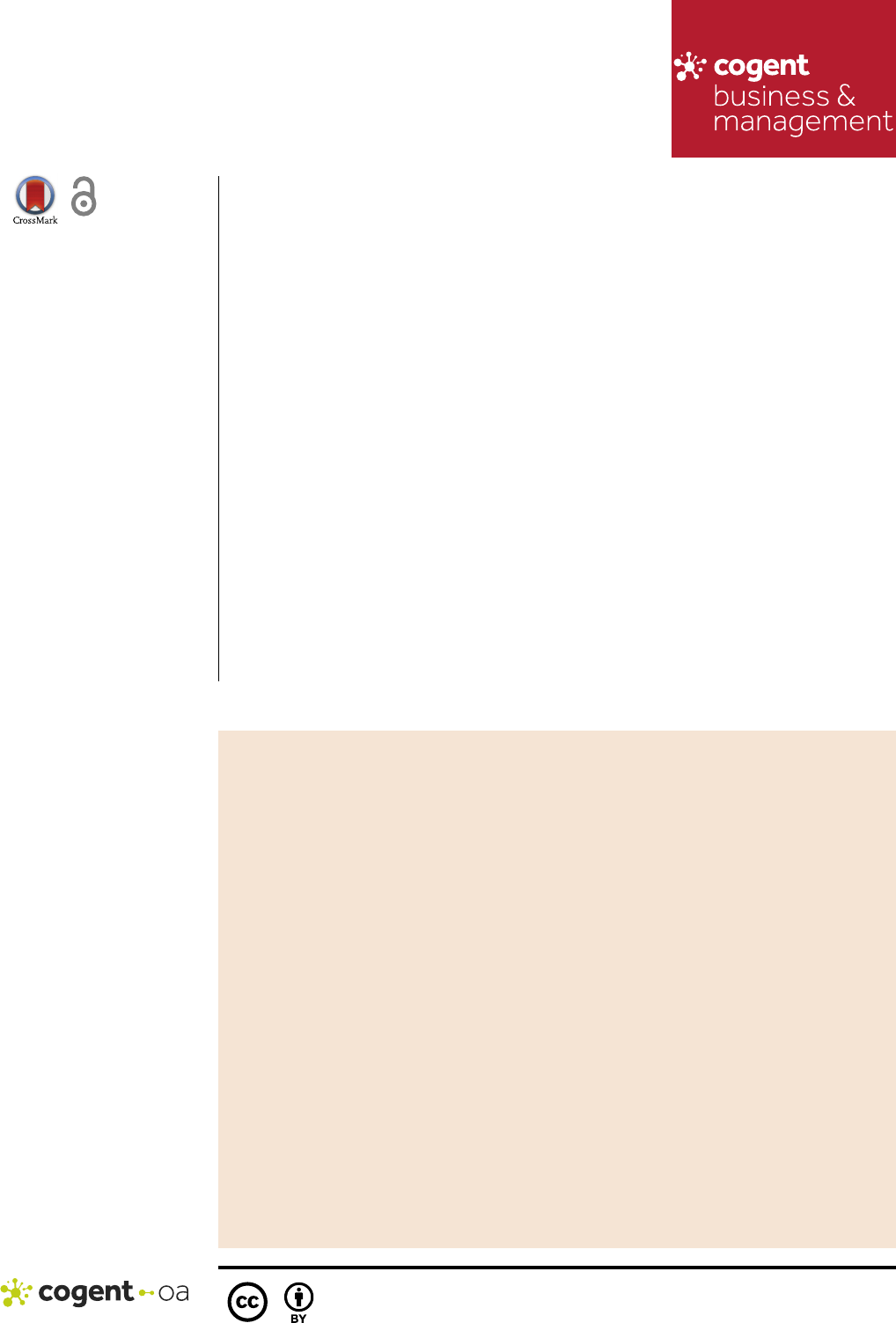
MARKETING | RESEARCH ARTICLE
Effect of mid-roll video advertising value and
perceived intrusiveness on Facebook viewers’
response: the mediating roles of attitude and
word-of-mouth intention
Jakkrit Thavorn
1
, Puripat Trichob
2
, Worasak Klongthong
1
and Chittipa Ngamkroeckjoti
2
*
Abstract: Advertising plays an essential role for creating brand awareness that
leads to consumer behavior toward services and products. The objective of this
research is to investigate the role of mid-roll video advertising regarding its per-
ceived intrusiveness and value on viewers’ response to those ads. Data from 200
users who have experienced mid-roll video advertising were analyzed in a two-step
method via structural equation modeling (SEM) and confirmatory factor analysis
(CFA). The indirect impacts were investigated and compared via the bootstrap
approach. The analysis confirms that the value of mid-roll video advertising is
significantly and positively associated with attitude toward mid-roll video advertis-
ing and word-of-mouth (WOM) intention. In addition, the positive connection
between WOM intention and attitude as well as viewers’ response are observed.
However, the negative association between perceived intrusiveness and attitude is
ABOUT THE AUTHORS
Jakkrit Thavorn holds a PhD in
Technopreneurship and Innovation
Management from Chulalongkorn University. His
current research interests include strategic
management, innovation management, tech-
nology management, foresight, and business
model innovation.
Puripat Trichob received his Master’s Degree in
Business Administration from the Graduate
School of Business and Advanced Technology
Management, Assumption University.
Worasak Klongthong received his PhD in
Technopreneurship and Innovation
Management from Chulalongkorn University. His
research interests cover general management,
marketing management, and data analytics.
Chittipa Ngamkroeckjoti is a full-time Assistant
Professor at the Graduate School of Business
and Advanced Technology Management,
Assumption University. Her research field is
International Business Management,
International Corporate Strategy, and
Qualitative & Quantitative Methodologies.
PUBLIC INTEREST STATEMENT
In 2021, social media have penetrated Thais’
perception successfully. Along with the pandemic
thoroughly consuming external environments,
advertisements (ads) on social media create
paths for brands and companies’ images to
attract consumers. Video advertising in social
media is used to promote their brands and the
contents of products and/or services. However,
video advertisements, especially mid-roll ads, can
lead to negative feelings because these ads
interrupt viewers’ experiences of the continuation
of content while they are watching them. In this
study, the role of the mid-roll-ad value and per-
ceived intrusiveness on viewers’ responses was
investigated based on the advertising value of the
1995’s Ducoffe’s model. In addition, the media-
tion effect of attitude toward mid-roll ads and
word-of-mouth intention was studied. The
exploratory sequential mixed-method was
applied. As a result, there was a positive rela-
tionship between mid-roll-ad value, attitude
toward mid-roll video advertising, and word-of-
mouth intention whereas perceived intrusiveness
had a negative effect on the attitude. This paper
highlights how advertisers strategize their content
to successfully attract and satisfy the viewers.
Thavorn et al., Cogent Business & Management (2022), 9: 2062091
https://doi.org/10.1080/23311975.2022.2062091
Page 1 of 22
Received: 01 November 2021
Accepted: 28 March 2022
*Corresponding author: Chittipa
Ngamkroeckjoti, 592/3
Ramkhamhaeng 24, Hua-Mak,
Bangkapi, Bangkok 10240 Thailand
E-mail: [email protected]
Reviewing editor:
Carlos Gomez Corona, Consumer
Research, Firmenich SA, Mexico
Additional information is available at
the end of the article
© 2022 The Author(s). This open access article is distributed under a Creative Commons
Attribution (CC-BY) 4.0 license.

found as well in this research. For the contributions, the result not only strengthens
the importance of the advertising value theory as a framework to explain the
impact of advertising, but also provides recommendations for advertisers and con-
tent creators regarding some managerial actions that may need to be taken in
order to satisfy consumers.
Subjects: Strategic Management; Marketing; Organizational Studies
Keywords: online ads; mid-roll advertising value; perceived intrusiveness; attitude; word-
of-mouth intention; viewers response; Facebook; Thailand
1. Introduction
Since opening to the public in 2006 till the present, Facebook, one of social networking sites (SNSs), has
been one of the third most favorite social global media platforms in January 2022 (or 14.5% of global
internet users aged between 16 and 64 years old). This figure increases more than 10.1% compared to
the previous year (Kemp, 2022). Among those developed and emerging countries, Thailand ranked 8
th
of Facebook users (or 50.05 million users in 2022; Statista, 2022). The advertising of a brand on
Facebook is considered a powerful social media tool to effectively keep in touch with consumers
and turbulent changes of their demands over a period of time (Kang & Park, 2018), especially during
the COVID-19 pandemic (2020 onwards). The advancing marketing characteristic of social media is
certainly an influential instrument in increasing both business sustainability and brand popularity
(Shareef et al., 2019). Based on the statistics, it portrays the significance of video as an instrument for
brands and companies to engage their customers in advertising (Gaber et al., 2019).
Videos are able to grab viewers’ attention intuitively. The popular social media platforms
including Facebook and YouTube have high video traffic. An average of 8 billion views are produced
by Facebook daily while the usage of Youtube’s mobile video increases to almost 100% each year
(Rawat et al., 2019). It is convincing that video ads are online ads which can certainly help to
increase users’ spending to around 50%. Video advertising, one of the effective marketing tools, is
employed largely by companies to promote their respective brands and products (S.-L. S.-L. Wang
& Lan, 2018). Furthermore, the sales rate of video advertisements is higher compared to static
advertisements, thus enabling them to be used in promoting certain products or brands.
Recently, Facebook has launched the option for content creators to earn money by inserting
short ads into their videos. With in-stream ads, creators tend to make longer, authentic contents
that can earn money by inserting ads into qualifying videos. There are many types of ad place-
ments that can be inserted into content, including pre-roll, mid-roll, post-roll, and image ads
(Widmer, 2017). On Facebook, in-stream advertisements attain approximately on-target rate of
89%. Publishers can adapt their advertisements based on their Facebook audiences so that those
advertisements can reach their targeted audience on Facebook. Therefore, creators can make
a decision on videos they need to monetize (Mogaji, 2016).
Ad completion rate is largely employed by the media industry in measuring the effectiveness of
an ad. Ad completion rate is defined as the percentage of ads which people view entirely and do
not stop watching in the midst (Krishnan & Sitaraman, 2013). The objective of any advertising
campaign is to minimize abandonment and maximize rates of completion. With the rise in internet
video traffic, people prefer to use mid-roll advertisements to promote their businesses. The
content, quality and placement of an ad are significant in determining if the user shows an interest
towards watching the ad. Therefore, it is essential to investigate the factors that affect viewers’
response in terms of mid-roll advertisements on Facebook.
Several advertising researches on mid-roll advertising in the social media (the test was started
at the beginning of 2016) has investigated “viewer response” replaced as “consumer response” in
Thavorn et al., Cogent Business & Management (2022), 9: 2062091
https://doi.org/10.1080/23311975.2022.2062091
Page 2 of 22

this study as the ones who react based on his/her actual behavior towards mid-roll advertisement
on Facebook (as abbreviated as mid-roll ads; Berman, 2017; Hsin Chang et al., 2013;
Kongsagoonwong & Ngamkroeckjoti, 2018; Mukherjee & Banerjee, 2017).
Following the success of mid-roll advertising in other video service providers like Hulu, NBC, CNN,
YouTube, and Netflix, Krishnan and Sitaraman (2013) found that the global highest completion
rate of 97% was generated when mid-roll ads were inserted in the midst of videos compared to
pre-roll ads and post-rolls ads which generated completion rates of 74% and 45% correspondingly.
However, Kongsagoonwong and Ngamkroeckjoti (2018) found that Thai viewers determined mid-
roll advertising on YouTube as interference and disturbing their enjoyment of specific programs.
Moreover, they are unlikely to pay attention to content or message and opt for skipping.
Other literature reviews had researched mid-roll advertising in the UK Facebook right after
started in 2016, in-stream advertisements attain an approximately on-target rate of 89%
(Mogaji, 2016). Others also found that 90% of US viewers consistently watched mid-roll advertising
through to completion (Weaver, 2018). As a result, it is the nature of mid-roll ads of which it lends
itself to a variety of higher-quality viewer experiences, and should not be overlooked (Weaver,
2018; Widmer, 2017). Therefore, if the creator and administrators of personal Facebook under-
stand the viewers’ response well, they will design the online content that matches with the
(updated changes of) demand of “Facebooker” or Facebook users. In other words, they can view
on a timely basis. The administrators’ list cope wbith a new mobile application that includes tools
for streaming video, updating Facebook stories, and messaging people across such platforms
among the creator and administrators’ personal homepages (Kim, 2015; Rawat et al., 2019).
Hence, the aim of this study is to explore and investigate the determinants of viewer response
toward mid-roll advertising on Facebook, with two research objectives. First, we intend to develop
a theoretical model to examine the relationships among mid-roll advertising value, perceived
intrusiveness, attitudinal dispositions, and word of mouth intention toward viewer response in
the context of Thai. Second, we hope to investigate the application of the social influence
theoretical model in this study. We believe that the study will offer useful insights for both
advertising scholars and executives to understand the intricacies of how mid-roll advertising
affects viewer response and to assist marketers in devising better approaches to increase the
effectiveness of mid-roll advertising.
In this research, mid-roll ads value is the perception of users regarding the effectiveness and
worthiness of the value when they watch the Facebook mid-roll ads. Consumers’ perceived
intrusiveness is defined as consumers’ moment of being obstructed undesirably by the Facebook
mid-roll ads. In addition, the role of attitude toward mid-roll ads and word-of-mouth (WOM)
intention is also investigated as a mediating effect. Attitude is defined as a person’s perception
toward mid-roll ads. WOM Intention refers to users’ eagerness to convey their thoughts regarding
the mid-roll ads to other users.
This research is rationally organized into five sections. The first section explains the theoretical
background while the second describes the research design and methodology. The findings and
analysis are presented in the third section. The discussion section is provided as the fourth while
the final concludes the study where the implications, limitations of this study, and suggestions for
future research are provided.
2. Theoretical background and hypotheses development
2.1. Mid-roll video advertising value, attitude toward mid-roll video advertising, and
word-of-mouth intention
This study selects two sub-categories under the advertising value based on interview results. There
are the quality of information and the credibility. Ducoffe (1995) has conceptualized advertising
Thavorn et al., Cogent Business & Management (2022), 9: 2062091
https://doi.org/10.1080/23311975.2022.2062091
Page 3 of 22

value (or ads value) from the traditional approach in 1995 till reaching social networking sites
(SNSs) in 1996 and 2000. This study concerns about ads value of consumers perspectives under-
neath social media tools like Facebook. Zha et al. (2015) define ads values as the general image
and evaluation of the value of an advertisement to consumer’s attitude. Hsin Chang et al. (2013)
researched the quality of information on ads via the internet that consumers care about to be
accepted. Such quality copes with the relationship between e-service quality and consumers.
Moreover, ads should convince their target consumers to have greater intention to purchase
those brands, in addition to having more positive influence on the society to avoid the feeling of
intrusiveness. These results correspond to what Ducoffe and Curlo (2000) conceived that ads value
as a subjective assessment of worthiness or usefulness of advertising to users while this research
focuses on viewers’ response on mid-roll ads on Facebook. However, an advertisement which is
lack value will generally lead to unfavorable users responses. One dimension of traditional value
that they defined as informativeness ads focuses on its quality which indicates valuable, impor-
tance, and usefulness. This study instead focuses insightful on the quality of information from mid-
roll ads on Facebook based on interview results in the context of Thai, such as easily sources of
information, supplying complete product/brand information, brand content, storyline, distribution,
and key messages towards their attitude to be accepted.
Yang et al. (2017) defined how trust of people or customers when watching the advertisement.
Mukherjee and Banerjee (2017) referred to credibility as how much ability of the advertisers deliver
trustworthiness to the receivers or audiencesthat has an impact on consumers’ attitude under the
social networking ads (SNAs). They added that in the perspective of SMS-based mobile advertise-
ments, credibility of ads has been considered as a critical determinant for shaping consumers’
attitude towards the SMS advertisements. In similar lines, in the context of SNAs, it can be
expected that advertisement credibility has a positive impact on users’/consumers’ attitude
towards SNAs. Lastly, Logan et al. (2012) mentioned credibility as the fairness and factualness
of advertising in customers’ perception. Based on qualitative results, this study concerns about
how trustworthiness of ads, credible advertisers, truthfulness of contents, and accurate of updated
ads on time delivery.
Attitude refers to a person’s sentiments and assessments towards engaging in a certain
behavior (Ajzen & Fishbein, 1980). In an advertising context, attitude is perceived as a tendency to
engender positively or negatively toward advertising content (Luna-Nevarez & Torres, 2015).
Values serve as the foundation of attitudes towards advertising (Beatty et al., 1985). The perceived
value of an advertisement is greatly influenced by attitude towards advertising (Brackett & Carr,
2001). The value of advertising has portrayed a substantial effect on attitude toward mobile
advertising. The perceived value of web advertising helps to attain satisfaction which in turn
motivates users to exhibit favorable behavior (Zha et al., 2015). Even though both sub-categories
have launched in several reviews, however as a result of the in-depth interview, they provide
deeper insightsto question in the quantitative format. Thus, Hypothesis 1 is proposed as follows:
H1: Mid-roll video advertising value has a positive impact on attitude toward mid-roll video
advertising.
From the advertising perspective, José-Cabezudo and Camarero-Izquierdo (2012) determined
the benefits of electronic word-of-mouth (or e-WOM) via email in terms of its provocative content
that motivate unpaid peer-to-peer communication of persuasive messages from identified spon-
sors. Therefore, it is also particularly important for the firms or brands to choose individuals who
are especially motivated to engage in viral dynamics, as an activity from which they derive
entertainment and an opportunity to share. Even though Individuals who require high levels of
trust (conveying the message or indicating the message in its subject line) are more reluctant and
engage in viral dynamics less. Furthermore, in Malaysia, Lim (2015) found a significant relationship
Thavorn et al., Cogent Business & Management (2022), 9: 2062091
https://doi.org/10.1080/23311975.2022.2062091
Page 4 of 22

also emerges between internet advertising and e-WOM which will reflect only the way people feel
as a result of persuasive communication. However, this study examines the relationship between
mid-roll advertising value and WOM intention. In addition, how the efficiency of consumers’
attitude mediates the relationship between advertising value and WOM intention. The explanation
of the relationship between attitude and WOM intention is proposed in the Hypothesis 5.
The received messages will be perceived by users as useful if those messages fulfill their
requirements or contain valuable purchase data. Previous research examined the association
between consumers’ response and advertising attitude (Tsang et al., 2004). They found that unless
consumers are specifically consented to advertising value, they normally have negative attitudes
toward that value. Thus, there is a relationship between consumer beliefs and attitudes and
consumer behavior. The increase of consumers’ purchase intention will make consumers to exhibit
a positive behavior towards services or products (Ko et al., 2005). Wahid and Ahmed (2011) also
found that attitude mediates between advertisement and response to purchase of the advertised
products. Similarly, attitude was found to fully mediate the relationship between value towards
ads and intention to refer the ads to others (Kumar & Kaushal, 2016). Thus, Hypothesis 2 and
Hypothesis 3 are proposed as follows:
H2: Mid-roll video advertising value has a positive impact on word-of-mouth intention.
H3: Attitude toward mid-roll video advertising mediates the effect of mid-roll video advertising on
word-of-mouth intention.
2.2. Perceived intrusiveness and attitude toward mid-roll video advertising
Perceived intrusiveness undesirably affects an individual’s experience by interrupting the indivi-
dual’s privacy (Cho, 2004). Nevertheless, advertisement is not the basis of interruption. Dutta-
Bergman, 2006 mentioned that the successful advertisement depends on its capability to
enlighten consumers. An ad is only perceived as disturbing if the users feel that the advertisement
disrupts their objectives (Edwards et al., 2002).
Advertising intrusiveness refers to an advertisement that disrupts the smoothness of an editorial
unit (Tudoran, 2019). People may develop an unfavorable response, particularly when users’
opinions of their anticipated content are inhibited by marketers or an ad can only be closed by
users after watching it for a specific amount of time (Ha & McCann, 2008). Furthermore, users’ level
of perceived intrusiveness relies on subjective decisions of varied requirements (Hsieh et al., 2021).
The online environment is more disturbing than traditional media (Belanche et al., 2017). The goal
of online advertisements is to grab the attention of users; however, online advertisements seem to
bring interruption to users (Tang et al., 2015). Advertisements with overstated or unclear statements
may cause users to feel disrupted. Users will also feel annoyed if the advertisements are too long or
loud (Bauer & Greyser, 1968). Moreover, an individual’s objectives may be disrupted by advertisement
intrusiveness, particularly when pop-up advertisements appear and obstruct users’ activities
(Pelsmacker et al., 2019). Madhavan et al. (2019) also found that perceived intrusiveness is negatively
associated with the online advertisement, publisher’s website, and attitude towards brand.
Following the interview results, the researcher has updated the operational components to fit
with the feedback of the respondents from mid-roll ads of Facebook. These are, for example, hard
sell, time consumption, threatening privacy, incongruency, and annoying behavior. Therefore,
Hypothesis 4 is proposed as follows.
.
H4: Perceived intrusiveness has a negative impact on attitude toward mid-roll video advertising.
Thavorn et al., Cogent Business & Management (2022), 9: 2062091
https://doi.org/10.1080/23311975.2022.2062091
Page 5 of 22

2.3. Attitude toward mid-roll video advertising and word-of-mouth (WOM) intention
Attitude toward consumer behavior implies the degree to which the execution of behavior is valued
either positively or negatively (Ajzen & Fishbein, 1980). An attitude of a person affects his or her actual
reaction and intentions toward products or services (Hsin Chang et al., 2013). Attitude toward
advertising refers to an individual’s tendency to demonstrate a positive or negative reaction towards
a certain advertisement (Chen & Wells, 1999). According to MacKenzie et al., 1986, an individual’s
behavioral disposition is greatly affected by his or her attitude toward advertising.
WOM intention is vital in making purchase-related choices. It is found that positive WOM will
enable new users to develop interests toward certain products or services (Jones & Reynolds,
2006). Consumers will usually share an advertisement that they like to their friends on social
media platforms. In this context, consumers act as initiators of marketing campaigns on social
media platforms. A favorable WOM can be developed through attitude toward marketing on social
media (Durukan & Bozaci, 2012). Once a favorable attitude is developed for the advertisement, it
influences consumers’ intention to share information (WOM).
Moreover, Mukherjee et al. (2017) investigated the impact of attitude towards SNAs on
WOM intention. They considered both positive and negative results from attitude toward SNAs
to be applied. Their results indicated that the attitude towards SNAs once it has a positive sign,
resulting in positive WOM intention. There was a strong relationship between the attitude and
WOM intentions. Besides, the attributes SNAs of entertainment and credibility were getting
along together very well; they both have a strong influence on the attitude of consumers. It is
very important to the marketers in terms of its image, sales, and alliance with prospective and
existing customers. Chu and Chen (2019) examine the positive relationship between brand
attitude and e-WOM intention of consumers’ CSR-related activities in social media. Accordingly,
it is plausible to expect that viewers’ attitudes affect the WOM intention. Thus, it is hypothe-
sized that:
H5: Attitude toward mid-roll video advertising has a positive impact on word-of-mouth intention.
2.4. Attitude toward mid-roll video advertising and viewer response
Purchase intention is the decision of consumers in choosing to purchase a certain product or
brand. It enables marketers to understand the view of potential consumers on actual purchase.
Online purchase intention refers to the concept which strengthens consumers’ aim to buy a certain
product or brand via online platforms (Salisbury et al., 2001). Purchase intention is directly affected
by product attitude. The substantial predictor of purchase intention in the location-based adver-
tising context is attitude (Xu et al., 2009). Similarly, the increase in stock price and customers’
purchase intention are affected positively by brand attitude (E.-B. E.-B. Lee et al., 2017).
Few research upon e-mail advertising revealed that the behavioral intentions of an individual
are affected positively by his or her behavioral disposition. Users who think e-mail advertisements
are valuable would be more probably to surf the website of the company or go to the physical
store (Martin et al., 2003). According to Trivedi and Teichert (2019), customers tend to develop
favorable intentions and reactions towards companies and their product offerings, especially when
they have a favorable fondness towards an advertisement. Therefore, customers’ reaction is
affected favorably by their favorable behavior towards advertisements on social networking sites
(Y. Y. Wang & Sun, 2010). Thus, the following hypothesis is proposed.
.
H6: Attitude toward mid-roll video advertising has a positive impact on viewer response.
Thavorn et al., Cogent Business & Management (2022), 9: 2062091
https://doi.org/10.1080/23311975.2022.2062091
Page 6 of 22
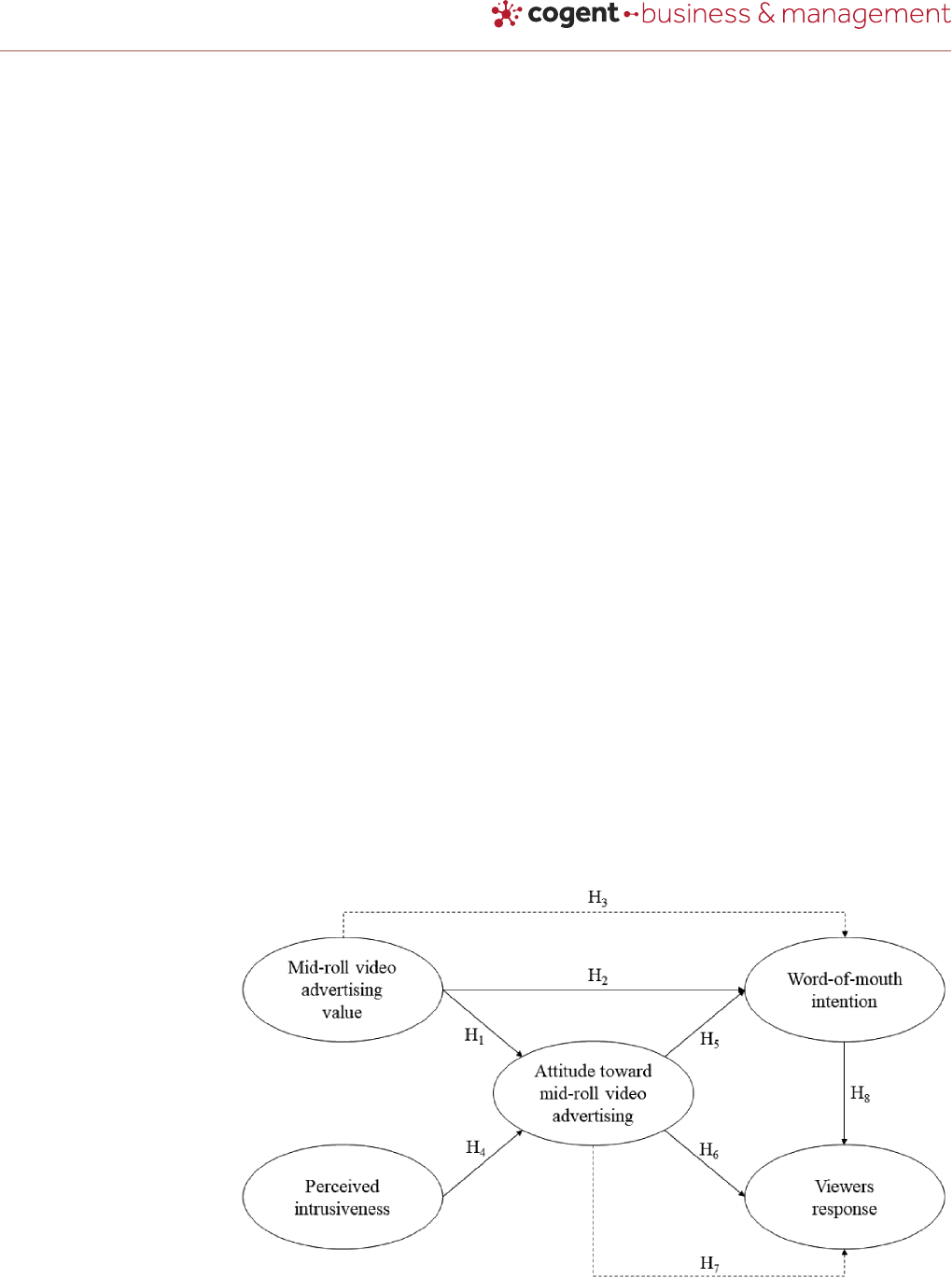
H7: Word-of-mouth intention mediates the effect of attitude toward mid-roll video advertising on
viewers’ response.
2.5. Word-of-mouth (WOM) intention and viewer response
It is found in previous studies that intention has a substantial connection with viewer response.
The willingness of a person to have an active involvement with marketers helps to portray viewer
response in marketing campaigns (Hsin Chang et al., 2013). According to Kent and Brandal (2003),
viewer response defines a customer’s actual behavior. Customers tend to develop favorable
intentions and reactions towards companies and their product offerings, especially when they
have a favorable fondness towards an advertisement. Martin et al. (2003) stated that customers
will tend to show more favorable reactions if they have positive intentions towards marketers.
Therefore, the following hypothesis is proposed:
H8: Word-of-mouth intention has a positive impact on viewer response.
2.6. The conceptual framework
The conceptual framework is to investigate the connection among viewers’ response through mid-
roll video advertising value, perceived intrusiveness, attitude toward mid-roll video advertising, and
word-of-mouth (WOM) intention. figure 1 depicts the model and research framework and Figure 2
shows the mediation effect of Hypothesis 3 and Hypothesis 7.
3. Methods
3.1. Exploratory Sequential Mixed Method Design
This research uses an exploratory sequential mixed method research which presupposes a specific
juxtaposition of the qualitative and quantitative components consequentially. According to
Creswell and Clark (2017), exploratory designs are useful for exploring relationships when study
variables are not known, refining and testing an emerging theory, developing new psychological
assessment instruments based on an initial qualitative analysis, and generalizing qualitative
findings to a specific population. This research also designated specifically supports the purpose
Figure 1. The conceptual fra-
mework.
Note: H
3
and H
7
refer to indirect
effects which were mediated by
attitude toward mid-roll video
advertising and word-of-mouth
intention, respectively.
Thavorn et al., Cogent Business & Management (2022), 9: 2062091
https://doi.org/10.1080/23311975.2022.2062091
Page 7 of 22
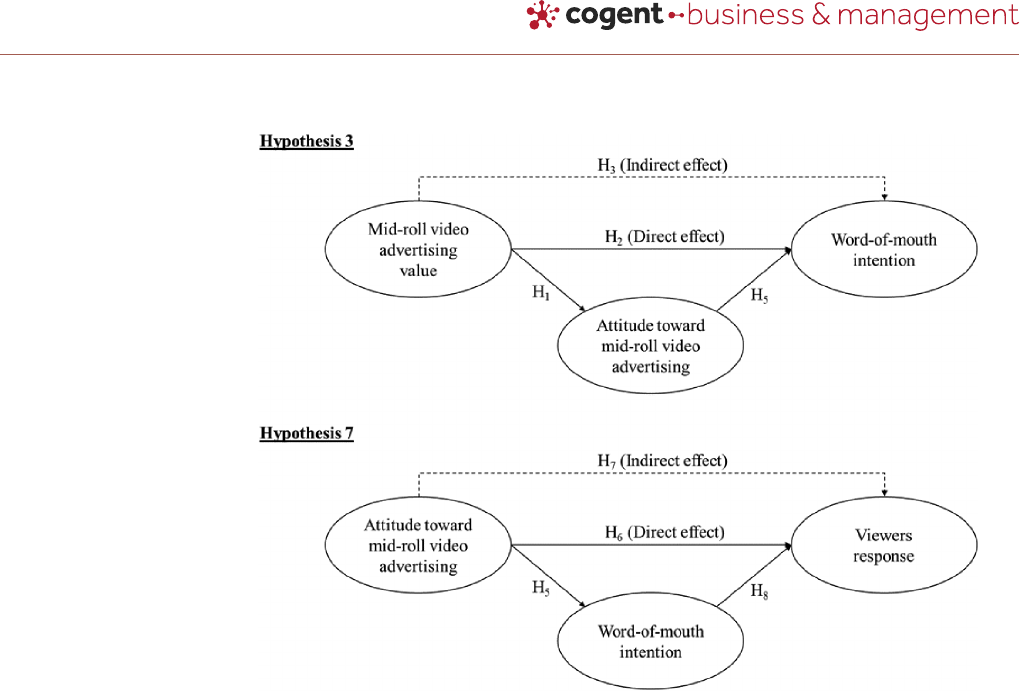
of the phenomenon of mid-roll advertising launched on Facebook since the beginning of 2017 in
Thailand (Wagner, 2017).
As shown in figure 3, the first phase of qualitative data collection and analysis is followed by the
collection of quantitative data to test or generalize the initial qualitative results (Schoonenboom &
Johnson, 2017). There are three rounds of interviews; however, up until the third round, inter-
viewers are able to confirm the application of both independent and dependent variables from
nine interviewees with marketing backgrounds from at least three international companies located
in Thailand. Each round provides the researchers as much closed to validate the ideas generated
from the qualitative component based on the related literature reviews. In addition, the research-
ers had initiated and confirmed the usage of additional components of perceived intrusiveness,
quality of information, and appropriate length of time. The specific new variables derived from
interviewing sessions are, for example, feeling forced (hard-sell), wasting my time, threatening
privacy, incongruent content, and interrupting the original video.
Finally, qualitative research methodologies are used to explore why or how a phenomenon
occurs, to describe the nature of an individual’s experience on mid-roll advertising on Facebook,
while quantitative methodologies address questions about causality, generalizability, or magni-
tude of such effect on Facebook viewers’ responses (Berman, 2017). Therefore, the designed
conceptual model (figure 1) was tested out to confirm its application of Facebook with the
samples. Findings are compared, with other literature reviews under a different context.
3.2. Sample selection and data collection
In order to investigate the research hypotheses and test the suggested model, an online survey
questionnaire was employed as a quantitative approach in this study. This research was conducted
aiming at Facebook users in Thailand. In this study, Facebook users who are more than 18 years
old and have experienced Facebook mid-roll video advertising were selected as the target
Figure 2. The mediation effect of
Hypothesis 3 and Hypothesis 7.
Thavorn et al., Cogent Business & Management (2022), 9: 2062091
https://doi.org/10.1080/23311975.2022.2062091
Page 8 of 22
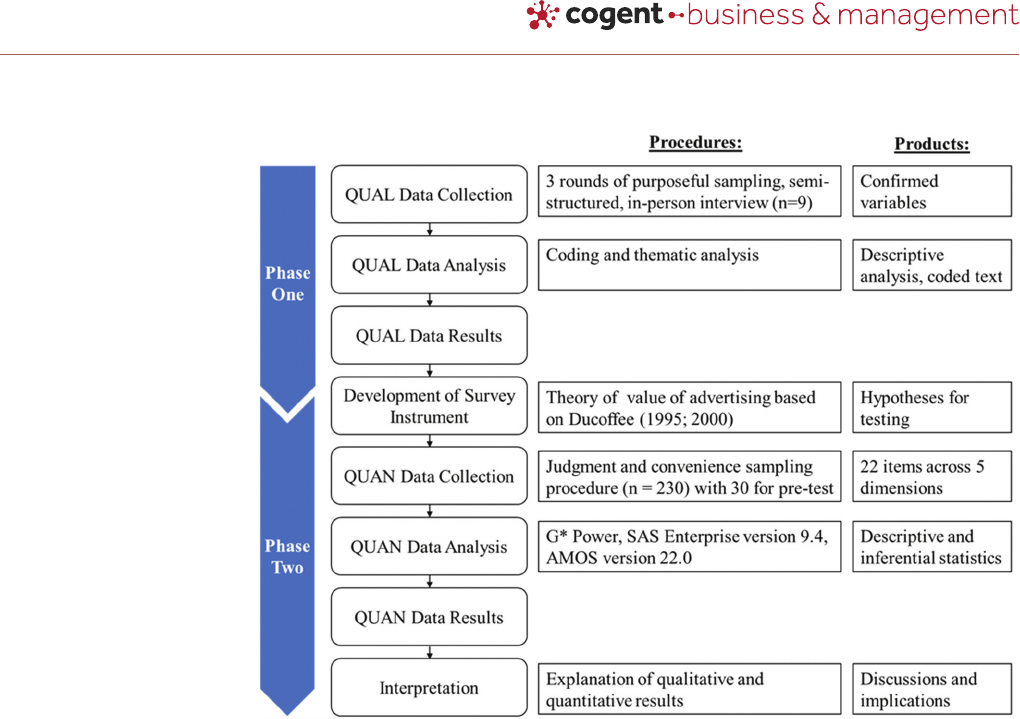
respondents. The online questionnaire survey was created via Google forms. The URL of the
surveys was sent through social media platforms, namely Facebook and LINE. The whole process
was undertaken on an entirely voluntary basis. The survey answers were sent to a link via Google
Form where data are stored in a password protected electronic format and confidentially kept.
Therefore, all responses remain anonymous. No one will be able to identify answers from respon-
dents. Facebook users were provided with a detailed explanation regarding the approach and
appropriate statistical tests that were applied when participating in the online survey.
According to Hair et al. (2010), structural equation modeling (SEM) analysis is suitable for
a minimum sample size of 200 or 10 cases per variable. This study contained 19 observable
variables, and thus the minimum sample size was 190. As a consequence, 200 surveys were
gathered after the data was collected and screened to be analyzed.
To assure the eligibility of respondents, screening questions such as “Have you ever seen/viewed
Facebook mid-roll video advertisings?” were applied in the survey. Respondents who provided
a “yes” answer are considered as the participants of the survey. When respondents took part in
the questionnaire, the definition of a Facebook mid-roll video advertising was explained to them as
follows: “Facebook mid-roll video advertising is activated for 5 to 15 seconds after viewer had
watched a video clip on Facebook for approximately 20 seconds without any authority to skip
button. Facebook makes its profit by offering the new advertising channel to the publishers for
their insert advertisements as video clips.”
3.3. Instrument development
In order to verify reliability and validity of the instruments, scales from previous studies were
adapted in this study. The questionnaires were divided into three parts: 1) screening questions, 2)
information regarding demographic and behavioral features of respondents, and 3) measurement
Figure 3. Exploratory sequential
mixed method design of this
research. Note: QUAL repre-
sents qualitative research and
QUAN represents quantitative
research.
Thavorn et al., Cogent Business & Management (2022), 9: 2062091
https://doi.org/10.1080/23311975.2022.2062091
Page 9 of 22

items. As for the measurement items, a four-point Likert scale was applied in this study ranging
from strongly agree (4) to strongly disagree (1).
The mid-roll video advertising value (VAL), which was the independent variable, was calculated
with five items in the proposed model, as per Hsin Chang et al. (2013). Perceived intrusiveness
(INTRU) was calculated with five items, as per Yang et al. (2017)) and Prendergast et al. (2009).
Attitude toward mid-roll video advertising (ATT) was assessed through three items, which was
altered from the findings of E.-B. E.-B. Lee et al. (2017). Word-of-mouth intention (WOM) was
assessed through three items, which was altered from the findings of Ranaweera and Karjaluoto
(2017). Viewers’ response (RES) was assessed through three items, which was altered from the
findings of Hsin Chang et al. (2013). The scale items are shown in Appendix (Table A1).
A pilot panel of 30 respondents was adopted to test the validity and reliability of the ques-
tionnaire. After that, we revised some minor improvements to ensure that the constructs were
well-understood, well-structured, evidently stated, and captured the key factors.
3.4. Data analysis
In order to conduct descriptive analysis, we employed Statistical Analysis System (SAS) software
version 9.4 in this study. Furthermore, the covariance-based structural equation modeling (CB-SEM)
was utilized in this study to analyze the data. This technique encompasses various statistical tools
such as path analysis for analyzing a multiple regression, factor loadings, and composite reliability
for assessing validity tests and reliability tests respectively. CB-SEM enables the exclusion of
measurement scales with low loadings such as lower than 0.5 and/or large error terms, thereby
improving the validity and reliability of the latent variables in the model, tested by the confirma-
tory factor analysis (CFA) (Hair et al., 2014). It also leads to the model with an acceptable fit,
verified by various indicators, between the observed and estimated models. In order to carry out
CFA and SEM, Analysis of Moments Structure (AMOS) software version 22.0 was employed to assess
the proposed hypotheses.
4. Results
4.1. Sample profile
A self-completed online questionnaire format was used to gather data in this study. Respondents
made an attempt to recollect their experience with the mid-roll advertisement via the Facebook
platform. According to their own opinions about mid-roll video advertising, respondents answered
the questions in the questionnaire. A total of 200 valid questionnaires were consolidated for the
purpose of analyzing the data. In order to investigate the demographic information, descriptive
statistics via SAS was applied in this study. It is portrayed that there were 56.50% of male
respondents while 42.50% of them were female respondents. Majority of the respondents were
aged between 25 and 34 years (79.50%), were single (91.00%), earned a bachelor’s degree
(68.00%), and were employed as employees in firms (68.50%).
4.2. Measurement model assessment
Confirmatory factor analysis (CFA) was applied in this study to assess the connection between the
constructs and their retained items. To evaluate the presumed connections among the variables,
separate tests and a complete CFA model for significance were conducted. There were five latent
variables and 19 observable variables in the proposed model. Table 1 portrays the constructs and
items for the measurement model.
To ensure the reliability of the model variables, the value of Cronbach’s alpha coefficient for each
of the constructs, corresponding to their scales, is between 0.767 and 0.845. These values are
larger than 0.7, ensuring the internal consistency of each construct (Taber, 2018). In addition, the
convergent validities of each construct were also computed. There are three requirements that
should be taken into account when measuring the convergent validity: 1) composite reliability (CR)
Thavorn et al., Cogent Business & Management (2022), 9: 2062091
https://doi.org/10.1080/23311975.2022.2062091
Page 10 of 22

of each construct has a value of at least 0.7; 2) average variance extracted (AVE) has a value of at
least 0.5; and 3) standardized factor loading has statistical significance of at least 0.5 (Awang,
2015). Table 1 portrays the convergent validity of the adjusted measurement model.
Overall, the acceptable level of the construct validity is shown through assessing results which
implicit that the 5 latent variables are reasonably fit for further structural model assessment.
Below are indicators of the goodness-of-fit for the measurement model: Chi-square = 249.578;
Degree of freedom = 134; Chi-square/degree of freedom (CMIN/df) = 1.86 (<3.00) (Hair et al.
(2010)); Goodness-of-fit index (GFI) = 0.90 (≥0.90; Marsh et al. (2020)); Comparative fit index
(CFI) = 0.941 (≥0.90); (Hu and Bentler (1999); Tucker—Lewis index (TLI) = 0.924 (≥0.90; Hox et al.
(2017); Root mean square error of approximation (RMSEA) = 0.066 (≤0.08) (Meyers et al. (2005)).
According to the data analysis, the goodness-of-fit indices met all requirements in the measure-
ment, thereby the data were in a good fit and structural model analysis could be further conducted
for the model.
Furthermore, the discriminant validity stipulates the extent of helping to distinguish each con-
struct (Rönkkö & Cho, 2020). In order to ensure the discriminant validity of constructs or latent
variables, the square root of AVE should be higher than the relationship between the respective
construct and other constructs. If any two latent variables possess an AVE which are larger than
the squared correlation (or coefficients) between those variables, they will thus possess discrimi-
nant validity. Table 2 depicts that all pairs of latent variables possess discriminant validity.
Table 1. Result of the adjusted measurement model
Constructs Standardized
factor loading
SE Critical ratio AVE CR Cronbach’s
alpha
VAL 0.536 0.848 0.843
VAL1 0.896 0.238 7.622
VAL2 0.633 0.145 8.213
VAL3 0.885 0.209 7.786
VAL4 0.587 0.146 6.754
VAL5 0.592 - -
INTRU 0.554 0.859 0.831
INTRU1 0.625 0.114 8.793
INTRU2 0.878 0.101 12.211
INTRU3 0.619 0.106 9.239
INTRU4 0.788 - -
INTRU5 0.776 0.111 9.909
ATT 0.694 0.871 0.845
ATT1 0.917 - -
ATT2 0.819 0.073 13.146
ATT3 0.755 0.106 9.196
WOM 0.559 0.786 0.767
WOM1 0.538 - -
WOM2 0.848 0.183 7.610
WOM3 0.818 0.193 7.515
RES 0.615 0.826 0.821
RES1 0.678 - -
RES2 0.783 0.120 9.685
RES3 0.878 0.121 10.503
Note: SE = Standard error, AVE = Average variance extracted, and CR = Composite reliability
Thavorn et al., Cogent Business & Management (2022), 9: 2062091
https://doi.org/10.1080/23311975.2022.2062091
Page 11 of 22

4.3. Structural model assessment
After assessing the measurement model, a structural model was analyzed using AMOS software
(version 22.0) to proceed a path analysis in order to examine the associations in the proposed
model. Below are the indicators of the goodness-of-fit indices: Chi-square = 278.846; Degree of
freedom = 137; Chi-square/degree of freedom (CMIN/df) = 2.035 (<3.00) (Hair et al. (2010);
Goodness-of-fit index (GFI) = 0.90 (≥ 0.90; Marsh et al. (2020); Comparative fit index
(CFI) = 0.927 (≥0.90; Hu and Bentler (1999)); Tucker—Lewis index (TLI) = 0.909 (≥0.90; Hox et al.
(2017); Root mean square error of approximation (RMSEA) = 0.072 (≤0.08) (Meyers et al. (2005).
The indicators fulfilled cutoff values, thus showing that the SEM model was a good fit.
Hypothesis 1 purposed that mid-roll video advertisings value is positively associated with attitude
toward mid-roll video advertising. The results revealed that there was a positive relationship
between the variables (β = .574, p < .001). The result was also statistically significant. Therefore, it
supported hypothesis 1. Mid-roll video advertisings value had positive relationship with WOM inten-
tion (β = .173, p < .05), hence supporting hypothesis 2. Conversely, perceived intrusiveness was
negatively associated with attitude toward mid-roll video advertising (β = −.335, p < .001), thus
supporting hypothesis 3. It was revealed that attitude toward mid-roll video advertisings had
a significant positive effect on WOM intention (β = .636, p < .001) and viewers response (β = .355,
p < .001), therefore supporting hypotheses 4 and 5. Furthermore, WOM intention showed positive
significant influence on viewers response (β = .536, p < .001), thereby supporting hypothesis 6.
Table 2. Discriminant validity of constructs
Construct VAL INTRU ATT WOM RES
VAL 0.536
INTRU 0.030 0.554
ATT 0.372 0.154 0.694
WOM 0.320 0.154 0.526 0.559
RES 0.317 0.305 0.510 0.632 0.615
Note: Italic bold values along the diagonal line represent the average variance extracted (AVE) while the other entries
represent the squared correlations.
Figure 4. Standardized path
coefficient and adjusted
R-squared.
Note: *** p < .001, * p < 0.05.
Thavorn et al., Cogent Business & Management (2022), 9: 2062091
https://doi.org/10.1080/23311975.2022.2062091
Page 12 of 22
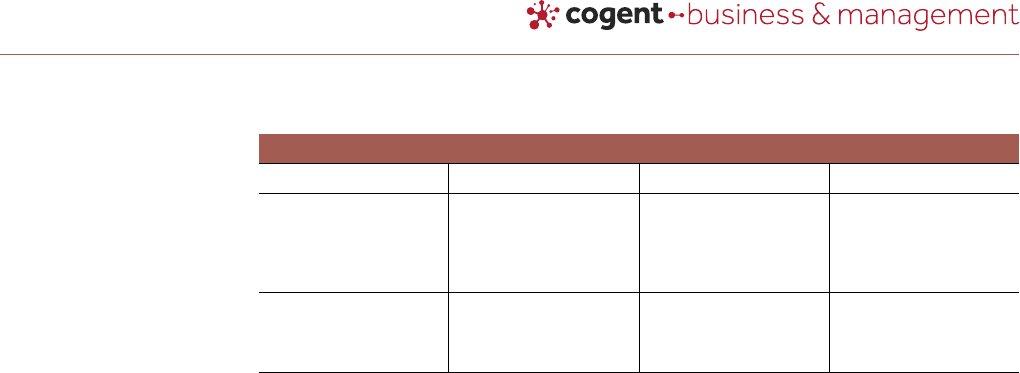
The predictive power of a path model could be assessed through examining the coefficient of
determination (R-squared) of each hypothesized construct with higher values, suggesting greater
precision of prediction (Hair et al., 2010). Figure 4 portrays the test results of each hypothesis
which show the R-squared values and relationship significance of variables.
In order to test the mediation effect of mid-roll video advertisings value towards WOM intention via
attitude toward mid-roll video advertising, a bootstrapping technique was applied in this study with
95% bias-corrected confidence level (Yu et al., 2021). The results of mediation analysis showed that
mid-roll video advertisings value had a direct effect on WOM intention (β = .173, p < .05), and WOM
intention through attitude toward mid-roll video advertising had a considerable indirect effect of .365
(.574 x .636), confirming partial mediation (Collier, 2020).
Viewers response was directly affected by attitude toward mid-roll video advertisings (β = .355,
p < .001). The indirect coefficients were assessed and the mediating variable was involved. Then, WOM
intention was added to the model. The path coefficients (Attitude toward mid-roll video advertising →
WOM intention and WOM intention → viewers response) had an indirect value of .341 (.636 x .536),
suggesting partial mediation (Collier, 2020). Table 3 summarizes the mediation test results.
Table 4 shows the summary of all hypotheses testing both direct effect and indirect effect.
5. Discussions and implications
5.1. Discussions of the findings and research contribution
There are twofold contributions illustrated in this study. Firstly, this study offers the application of
fitted-in operational components with SNSs, especially Facebook. There are, for example, mid-roll
advertising value, perceived intrusiveness, ads attitude, WOM intention, and consumer response.
Second, this study offers a comprehensive theoretical model to explain the effectiveness of mid-
roll Facebook advertising.
The first objective provides insight of the adjusted variables to fit antecedents influencing view-
ers’ response on mid-roll advertising on Facebook based on the qualitative method. To achieve this
goal, the researchers developed semi-structured interview questions to gain a genuine feeling
from the target interviewees who had at least used Facebook more than 2 hours per day every day
in the past 6 months (from March to August). We had interviewed three rounds to gain the most
specific components till data is redundant at the end. As a result, this study found different
responses towards ads between email and Facebook. You only read ads in email while watching
ads in the form of videos on Facebook. Therefore, operational dimensions were re-designed and/or
re-adjusted to fit with a Facebook page (see Appendix (Table A2)).
The second objective provides an insightful presentation on how mid-roll ads value and other
antecedents influence viewers’ response and tests all hypotheses. To reach that goal, we re-
Table 3. Mediation test results
Path Direct effect Indirect effect Result
H3: Mid-roll video
advertisings value →
Attitude toward mid-roll
video advertisings → WOM
intention.
.173* .365*** Partial mediation
H7: Attitude toward mid-
roll video advertisings →
WOM intention → viewers
response.
.355*** .341*** Partial mediation
Note: *** p < .001, * p < 0.05.
Thavorn et al., Cogent Business & Management (2022), 9: 2062091
https://doi.org/10.1080/23311975.2022.2062091
Page 13 of 22
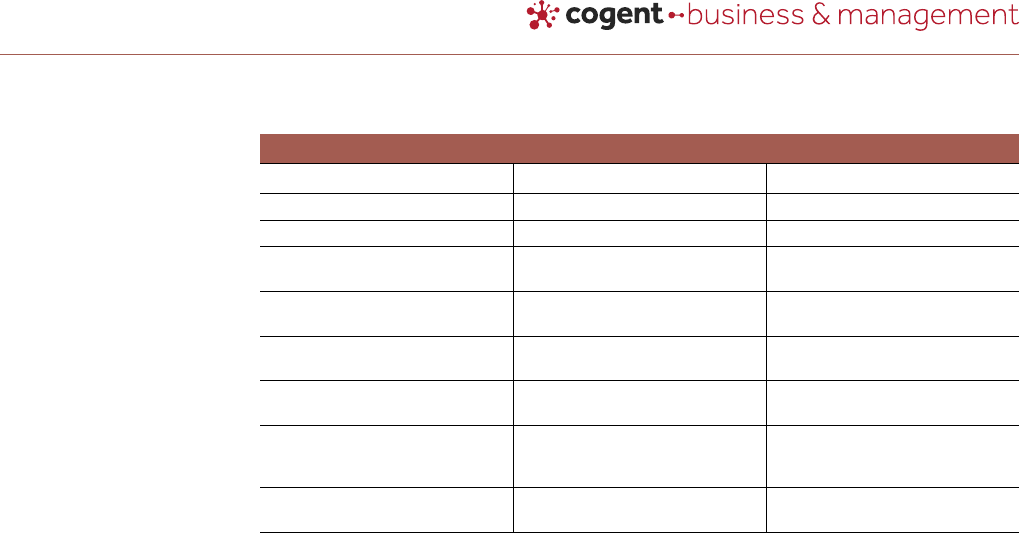
developed a theoretical model investigating the relationships among (after transformed) mid-roll
ads value, attitude, perceived intrusiveness, word-of-mouth intention, and viewers’ response. The
results show that there are either positive or negative significant relationships amongst all vari-
ables (see Table 4).
The findings of this study indicated that all the proposed hypotheses are supported. This study makes
the contributions to the marketing literature and practice. Firstly, we aimed to demonstrate that if mid-
roll ads on Facebook show their appropriate values they will be perceived as less intrusive to viewers, thus
leading to a greater tendency for Facebook to influence the consumer’s attitudinal and behavioral
dispositions. Even though Y.-G. Y.-G. Lee et al. (2016) and Mukherjee and Banerjee (2017) generally
focused on credibility and reliability of product/service information shown in the ads via television and/or
SNSs; however, our results specifically show up-to-date information without faking ones of ads will surge
higher favorable attitude of viewers’ response on time. Such quality information and the positive attitude
of FMVAs will play a major role to make customers understand clearly what the advertisers want to
convey the key message to others (Hsin Chang et al., 2013). Therefore, our results added on those positive
viewers will further discuss those key information derived from FMVAs more with others confirmed by
Ranaweera and Karjaluoto (2017) whose their work pointed out that a positive attitude will influence
a positive response. Our results successfully lead to a precise and up-to-date portrait of ads value towards
positive attitude and positive WOM intention under the context of MVAs of Facebook in Thailand.
Secondly, another proposition result we constructed was between the perceived intrusiveness and
attitude towards FMVAs. There is a negative relationship between perceived intrusiveness and favorable
attitudes. According to Logan et al. (2012) and McCoy et al. (2017), users’ attitudes towards a website are
affected by intrusive advertisements. Longer pre-roll and mid-roll video advertisements will increase
consumers’ unfavorable attitudes and feelings of intrusiveness towards those advertisements (Goodrich
et al., 2015). Abbasi et al. (2021) proposed that advertisers should comprehend consumers’ interest and
need as well as create a shorter version of advertisements with attractive content to overcome the
occurrence of perceived intrusiveness. Our result complies with those above models, we found that the
less those FMVAs interrupt the original video content, the more the favorable attitude towards FMVAs.
Thirdly, the final proposition was the direct and indirect relationships among variables including
attitude of FMVAs, WOM intention, and viewers’ response. Our result proved that all hypotheses
both direct and indirect show significant positive relationships among others. These results corre-
spond to the model designed by Hsin Chang et al. (2013) and Ranaweera and Karjaluoto (2017).
Table 4. Hypotheses testing results
Hypothesis Relationship Result
H
1
: FMVAs value → FMVAs attitude Direct Significant positive relationship
H
2
: FMVAs value → WOM intention Direct Significant positive relationship
H
3
: FMVAs value → FMVAs Attitude
→ WOM intention (Indirect)
Indirect Significant positive relationship
H
4
: Perceived intrusive → FMVAs
attitude
Direct Significant negative relationship
H
5
: FMVAs attitude → WOM
intention
Direct Significant positive relationship
H
6
: FMVAs attitude → Viewer
response
Direct Significant positive relationship
H
7
: FMVAs attitude → WOM
intention → Viewer Response
(Indirect)
Indirect Significant positive relationship
H
8
: WOM intention → Viewer
response
Direct Significant positive relationship
Thavorn et al., Cogent Business & Management (2022), 9: 2062091
https://doi.org/10.1080/23311975.2022.2062091
Page 14 of 22

To be more specific, Hsin Chang et al. (2013)’s model design indicates that the person’s attitude
will lead to behavior/action, which means that if a person has a positive attitude towards the ads,
he/she will positively intend to purchase or react towards ads. Our result corresponds to their
model which suggests that higher viewers’ favorable attitude that viewers think Facebook using
MVA’s is a smart idea, those will make use of ads video received in FMVAs.
A parallel relationship corresponds with Ranaweera and Karjaluoto (2017), who said that a positive
attitude will influence positive behaviour while this study points out that the higher viewers’ favorable
attitude that viewers think Facebook using FMVAs is a smart idea. Also, the model of Lien and Cao (2014)
revealed that attitudes significantly influence positive WOM behavior. This is in line with the findings of
Shih et al. (2013), showing that attitudes toward an online ad had a positive impact on WOM intention.
Consumers are generally more willing to suggest advertisements shown on social media platforms to
others since they like those ads or their content.
Moreover, Ranaweera and Karjaluoto (2017) and Kwok et al. (2019) showed that WOM and e-WOM are
key customer engagement and lead to purchase intention or positive response while this study if viewers
discuss any MVAs with others, those will make use of advice received in FMVAs. In conclusion, our results
successfully lead attitude and WOM intention towards MVAs of Facebook to viewers’ response. In other
words, a positive attitude towards the quality of advs will lead viewers to intend to have positive WOM
and to positively viewers’ response. Therefore, the advertisers who would like to put mid-rolls ads should
confirm the much higher value of ads to gain positive viewers attitude which led to a positive response at
the end.
For the theoretical contribution, this research offered a more understanding about the position of mid-
roll video ads value and intrusiveness. This research confirmed that the quality of mid-roll video ads value
and intrusiveness tended to be the factor that fostered the attitude toward mid-roll video ads, which
determined the level of WOM intention and viewers response on social media platform. The result
strengthened the importance of the Ducoffe theory in explaining the benefits of advertising value,
intrusiveness, attitude, and WOM intention, which were also consistent with the findings from prior
studies.
5.2. Practical implications
This research provides a recommendation for content creators and advertisers regarding
some managerial actions that may need to be taken in order to formulate and strategize
advertising for better reach and engagement. Firstly, content creators and advertisers should
provide the interesting and appropriate content to attract viewers’ attention. Moreover, the
length of ads time should be concise and get to the points as quickly as possible. The
storytelling advertising with verbal and visual components is recommended to create positive
consumers’ attitude (Tresa Sebastian et al., 2021).
Secondly, mid-roll video advertising can be shown during native videos, including live videos that
are being broadcasted in real-time. Thus, publishers and advertisers should match the content of
an advertisement to its targeted viewers. Publishers and advertisers may want to aim at including
advertisements in particular videos directly or remove some content completely based on their
targeted consumers. Furthermore, advertisers can apply the personalizing advertisement to match
their content with viewers’ memories on Facebook.
Lastly, publishers should consider their goals and disable non-skippable ads. In the midst of
generating brand awareness in a campaign, advertisers should make sure that the contents
of their advertisements present brand awareness favorably. Advertisers should consider their
targeted audience while planning to promote their brands. Advertisers should let the viewers
to be able to skip an advertisement after 5 seconds and this will certainly leave a good
impression. Viewers will be more likely to view the advertisement completely when they see it
Thavorn et al., Cogent Business & Management (2022), 9: 2062091
https://doi.org/10.1080/23311975.2022.2062091
Page 15 of 22

again in the future. Skippable function in an advertisement may be appropriate for the initial
campaign in order to get positive viewers’ response.
6. Conclusions, limitations, and further research
This study provides the latest insights into the understanding of factors determining con-
sumer behaviour, in other words, viewers’ response used in this study toward mid-roll ads on
Facebook. The exploratory sequential mixed method has been conducted to examine how to
improve mid-roll advertisement based on social networking sites (SNSs) especially Facebook.
We found perceptively new dimensions of the cognitive feeling of each variable used in this
framework. It is observed that all proposed hypotheses are found to fit the data of the study and
are supported. We also discover that attitude acted as a mediator for the relationship between ads
value while WOM intention for the attitude and consumer behaviour. Overall, this work contributes
to the development of a new theoretical model to explain the viewer response toward mid-roll
advertisements on Facebook.
Despite having contributions in the study, there are some limitations that still need to be acknowl-
edged. Firstly, this study used the cross-sectional method for collecting data. Therefore, this study could
only provide results that reflect the association between variables. The findings of this study require
future studies that use the experimental method to prove the causality between the variables. In
addition, this research was conducted before the coronavirus pandemic. After the pandemic, consumers
have embraced their digital lifestyle, leading to changes in social media habits. It is suggested to conduct
longitudinal research in order to find out the ways that users alter their perceived intrusiveness, attitude,
intention, and their response over time.
Secondly, the respondents in this study are mostly in the age between 25 and 34 years
(accounted for 79.5% of total respondents). This may lead to the conclusion of the viewer
response toward the mid-roll ads in a particular age range. However, this age range is the
main population in Thailand who spend most of the time on social media (e.g., Facebook),
thus the results can be useful for marketers to launch appropriate ads on Facebook to get
positive feedback from the main viewers.
Thirdly, the research was conducted using the sample of Facebook users in Thailand. Since the
research only involved users of a country, the results may not be generalized to users in other
nations. In order to verify and broaden the results, it is suggested that future research can assess
the proposed model by using the sample in other nations.
Besides that, this study only involved Facebook throughout the process of conducting this study.
Therefore, it is recommended that different types of social media can be employed in future
research to compare and examine the differences in mid-roll video advertising among a variety
of social media platforms.
Acknowledgements
This research was supported by the Graduate School of
Business and Advanced Technology Management,
Assumption University.
Funding
The authors received no direct funding for this research.
Author details
Jakkrit Thavorn
1
ORCID ID: http://orcid.org/0000-0002-8341-4203
Puripat Trichob
2
ORCID ID: http://orcid.org/0000-0003-1186-2581
Worasak Klongthong
1
ORCID ID: http://orcid.org/0000-0003-1717-216X
Chittipa Ngamkroeckjoti
2
E-mail: [email protected]
ORCID ID: http://orcid.org/0000-0003-0165-712X
1
Technopreneurship and Innovation Management
Program, Graduate School, Chulalongkorn University,
Bangkok, Thailand.
2
Graduate School of Business and Advanced Technology
Management, Assumption University, Bangkok,
Thailand.
Disclosure statement
No potential conflict of interest was reported by the author(s).
Citation information
Cite this article as: Effect of mid-roll video advertising
value and perceived intrusiveness on Facebook viewers’
response: the mediating roles of attitude and word-of-
mouth intention, Jakkrit Thavorn, Puripat Trichob,
Thavorn et al., Cogent Business & Management (2022), 9: 2062091
https://doi.org/10.1080/23311975.2022.2062091
Page 16 of 22

Worasak Klongthong & Chittipa Ngamkroeckjoti, Cogent
Business & Management (2022), 9: 2062091.
References
Abbasi, A. Z., Rehman, U., Hussain, A., Ting, D. H., &
Islam, J. U. (2021). The impact of advertising value of
in-game pop-up ads in online gaming on gamers’
inspiration: An empirical investigation. Telematics
and Informatics, 62(6), 101630. https://doi.org/10.
1016/j.tele.2021.101630
Ajzen, I., & Fishbein, M. (1980). Understanding attitudes
and predicting social behaviour. Prentice-Hall.
Awang, Z. (2015). SEM made simple: A gentle approach to
learning structural equation modeling. MPWS Rich
Publication.
Bauer, R. A., & Greyser, S. A. (1968). Advertising in
America: The Consumer View. Harvard University.
Beatty, S. E., Kahle, L. R., Homer, P., & Misra, S. (1985).
Alternative measurement approaches to consumer
values: The list of values and the rokeach value
survey. Psychology & Marketing, 2(3), 181–200.
https://doi.org/10.1002/mar.4220020305
Belanche, D., Flavián, C., & Pérez-Rueda, A. (2017). User
adaptation to interactive advertising formats: The
effect of previous exposure, habit and time urgency
on ad skipping behaviors. Telematics and Informatics,
34(7), 961–972. https://doi.org/10.1016/j.tele.2017.
04.006
Berman, E. A. (2017). An exploratory sequential mixed
methods approach to understanding researchers’
data management practices at uvm: integrated
findings to develop research data services. Journal of
eScience Librarianship, 6(1), e1104. https://doi.org/10.
7191/jeslib.2017.1104
Brackett, L. K., & Carr, B. N. (2001). Cyberspace advertising
vs. other media: Consumer vs mature student
attitudes. Journal of Advertising Research, 41(5),
23–33. https://doi.org/10.2501/JAR-41-5-23-32
Chen, Q., & Wells, W. D. (1999). Attitude toward the Site.
Journal of Advertising Research, 39(5), 27–37.
Cho, C.-H., (2004). Why do people avoid advertising on the
internet? Journal of Advertising, 33(4), 89–97. https://
doi.org/10.1080/00913367.2004.10639175
Collier, J. E. (2020). Applied structural equation modeling
using AMOS: Basic to advanced techniques.
Routledge, Taylor & Francis Group.
Creswell, J. W., & Clark, V. L. P. (2017). Designing and
conducting mixed methods research (3rd ed.). Sage
Publications.
Ducoffe, R. H. (1995). How consumers assess the value of
advertising. Journal of Current Issues and Research in
Advertising, 17(1), 1–18. https://doi.org/10.1080/
10641734.1995.10505022
Ducoffe, R. H., & Curlo, E. (2000). Advertising value and
advertising processing. Journal of Marketing
Communications, 6(4), 247–262. https://doi.org/10.
1080/135272600750036364
Durukan, T., & Bozaci, I. (2012). A survey on determinants of
word of mouth in social media. International Journal of
Economics and Management Sciences, 1(7), 36–44.
Dutta-Bergman, M. J. (2006). The demographic and psy-
chographic antecedents of attitude toward
advertising. Journal of Advertising Research, 46(1),
102–111. https://doi.org/10.2501/
S0021849906060119
Edwards, S. M., Li, H., & Lee, J.-H. (2002). Forced exposure
and psychological reactance: Antecedents and con-
sequences of the perceived intrusiveness of pop-up
ads. Journal of Advertising, 31(3), 83–95. https://doi.
org/10.1080/00913367.2002.10673678
Gaber, H. R., Wright, L. T., Kooli, K., & Kostadinova, E.
(2019). Consumer attitudes towards Instagram
advertisements in Egypt: The role of the perceived
advertising value and personalization. Cogent
Business & Management, 6(1), 1618431. https://doi.
org/10.1080/23311975.2019.1618431
Goodrich, K., Schiller, S. Z., & Galletta, D. (2015).
Consumer reactions to intrusiveness of
online-video advertisements. Journal of Advertising
Research, 55(1), 37–50. https://doi.org/10.2501/JAR-
55-1-037-050
Ha, L., & McCann, K. (2008). An integrated model of
advertising clutter in offline and online media.
International Journal of Advertising, 27(4), 569–592.
https://doi.org/10.2501/S0265048708080153
Hair, J., Black, W. C., Babin, B. J., & Anderson, R. E.
(2010). Multivariate Data Analysis (7th ed.).
Prentice Hall.
Hair, J., Gabriel, M., & Patel, V. (2014). AMOS
covariance-based structural equation modeling
(CB-SEM): Guidelines on its application as
a marketing research tool. Brazilian Journal of
Marketing, 13(2), 44–55. https://doi.org/10.5585/
remark.v13i2.2718
Hox, J. J., Moerbeek, M., & Schoot, R. V. D. (2017).
Multilevel analysis: Techniques and applications (3rd
ed.). Routledge, Taylor & Francis Group.
Hsieh, A.-Y., Lo, S.-K., Chiu, Y.-P., & Lie, T. (2021). Do not
allow pop-up ads to appear too early: Internet users’
browsing behaviour to pop-up ads. Behaviour &
Information Technology, 40(16), 1796–1805. https://
doi.org/10.1080/0144929X.2020.1784282
Hsin Chang, H., Rizal, H., & Amin, H. (2013). The determi-
nants of consumer behavior towards email
advertisement. Internet Research, 23(3), 316–337.
https://doi.org/10.1108/10662241311331754
Hu, L. T., & Bentler, P. M. (1999). Cutoff criteria for fit
indexes in covariance structure analysis:
Conventional criteria versus new alternatives.
Structural Equation Modeling: A Multidisciplinary
Journal, 6(1), 1–55.
Jones, M. A., & Reynolds, K. E. (2006). The role of retailer
interest on shopping behavior. Journal of Retailing, 82
(2), 115–126. https://doi.org/10.1016/j.jretai.2005.05.
001
José-Cabezudo, R. S., & Camarero-Izquierdo, C. (2012).
Determinants of opening-forwarding E-Mail
messages. Journal of Advertising, 41(2), 97–112.
https://doi.org/10.2753/JOA0091-3367410207
Kang, M. Y., & Park, B. (2018). Sustainable corporate social
media marketing based on message structural fea-
tures: Firm size plays a significant role as a
moderator. Sustainability, 10(4), 1167. https://doi.org/
10.3390/su10041167
Kemp, S. (2022). Digital 2022: Global overview report,
Datareportal. Retrieved 15 March 2022 from https://
datareportal.com/reports/digital-2022-global-
overview-report
Kent, R., & Brandal, H. (2003). Improving email response
in a permission marketing context. International
Journal of Market Research, 45(4), 1–13. https://doi.
org/10.1177/147078530304500404
Kim, S. (2015). Effects of Ad-Video Similarity, Ad Location,
and User Control Option on Ad Avoidance and
Advertiser-Intended Outcomes of Online Video Ads.
(University of Minnesota). https://hdl.handle.net/
11299/175210
Ko, H., Cho, C.-H., & Roberts, M. S. (2005). Internet uses
and gratifications: A structural equation model of
interactive advertising. Journal of Advertising, 34(2),
Thavorn et al., Cogent Business & Management (2022), 9: 2062091
https://doi.org/10.1080/23311975.2022.2062091
Page 17 of 22

57–70. https://doi.org/10.1080/00913367.2005.
10639191
Kongsagoonwong, T., & Ngamkroeckjoti, C. (29-30
November 2018). A reflection of mid-roll YouTube
Advertising effectiveness (MYAe): A case study in
Thailand. Proceedings of the 8th national and inter-
national conference on humanities and social
sciences, Prince of Songkla University, Phuket,
Thailand.
Krishnan, S. S., & Sitaraman, R. K. (2013). Understanding
the effectiveness of video ads: A measurement
study. The 2013 Internet Measurement Conference,
October, 23-25, 2013. (Association for Computing
Machinery: Barcelona, Spain). https://doi.org/10.
1145/2504730.2504748
Kumar, R., & Kaushal, S. K. (2016). Influence of attitude
towards advertisement on purchase intention:
Exploring the mediating role of attitude towards
brand using SEM Approach. The IUP Journal of
Marketing Management, 15(4), 44–59. https://ssrn.
com/abstract=3075718
Kwok, L., Mao, Z., & Huang, Y.-K. (2019). Consumers’
electronic word-of-mouth behavioral intentions on
Facebook: Does message type have an effect?
Tourism and Hospitality Research, 19(3), 296–307.
https://doi.org/10.1177/1467358417742684
Lee, Y.-G., Byon, K. K., Ammon, R., & Park, S.-B. R. (2016).
Golf product advertising value, attitude toward
advertising and brand, and purchase intention. Social
Behavior and Personality: An International Journal, 44
(5), 785–800. https://doi.org/10.2224/sbp.2016.44.5.
785
Lee, E.-B., Lee, S.-G., & Yang, C.-G. (2017). The influences
of advertisement attitude and brand attitude on
purchase intention of smartphone advertising.
Industrial Management & Data Systems, 117(6),
1011–1036. https://doi.org/10.1108/IMDS-06-2016-
0229
Lien, C. H., & Cao, Y. (2014). Examining WeChat users’
motivations, trust, attitudes, and positive word-of-
mouth: Evidence from China. Computers in Human
Behavior, 41(12), 104–111. https://doi.org/10.1016/j.
chb.2014.08.013
Lim, W. M. (2015). The influence of internet advertising
and electronic word of mouth on consumer percep-
tions and intention: Some evidence from online
group buying. Journal of Computer Information
Systems, 55(4), 81–89. https://doi.org/10.1080/
08874417.2015.11645790
Logan, K., Bright, L. F., Gangadharbatla, H., & Dix, S.
(2012). Facebook versus television: Advertising value
perceptions among females. Journal of Research in
Interactive Marketing, 6(3), 164–179. https://doi.org/
10.1108/17505931211274651
Luna-Nevarez, C., & Torres, I. M. (2015). Consumer atti-
tudes toward social network advertising. Journal of
Current Issues & Research in Advertising, 36(1), 1–19.
https://doi.org/10.1080/10641734.2014.912595
MacKenzie, S. B., Lutz, R. J., & Belch, G. E. (1986). The Role
of attitude toward the ad as a mediator of advertis-
ing effectiveness: A test of competing explanations.
Journal of Marketing Research, 23(2), 130–143.
https://doi.org/10.1177/002224378602300205
Madhavan, V., George, S., Kidiyoor, G., & Pai, Y. P. (2019).
Perceived intrusiveness of rich media ads in online
advertising: Evidences from young Indian travellers.
Cogent Economics & Finance, 7(1), 1645631. https://
doi.org/10.1080/23322039.2019.1645631
Marsh, H. W., Guo, J., Dicke, T., Parker, P. D., & Craven, R. G.
(2020). Confirmatory factor analysis (CFA), explora-
tory structural equation modeling (ESEM), and
Set-ESEM: Optimal balance between goodness of fit
and parsimony. Multivariate Behavioral Research, 55
(1), 102–119. https://doi.org/10.1080/00273171.
2019.1602503
Martin, B. A. S., Durme, J. V., Raulas, M., & Merisavo, M.
(2003). Email advertising: Exploratory insights from
Finland. Journal of Advertising Research, 43(3), 293–
300. https://doi.org/10.1017/S0021849903030265
McCoy, S., Everard, A., Galletta, D. F., & Moody, G. D.
(2017). Here we go again! The impact of website ad
repetition on recall, intrusiveness, attitudes, and site
revisit intentions. Information & Management, 54(1),
14–24. https://doi.org/10.1016/j.im.2016.03.005
Meyers, L., Gamst, G., & Guarino, A. (2005). Applied
Multivariate Research: Design and Interpretation.
Sage Publications.
Mogaji, E., & Wright, L. T. (2016). This advert makes me
cry: Disclosure of emotional response to advertise-
ment on facebook. Cogent Business & Management, 3
(1), 1177906. https://doi.org/10.1080/23311975.
2016.1177906
Mukherjee, K., & Banerjee, N. (2017). Effect of social net-
working advertisements on shaping consumers’ atti-
tude. Global Business Review, 18(5), 1291–1306.
https://doi.org/10.1177/0972150917710153
Pelsmacker, P. D., Dens, N., & Verberckmoes, S. (2019).
How ad congruity and interactivity affect fantasy
game players’ attitude toward in-game advertising.
Journal of Electronic Commerce Research, 20(1),
55–74.
Prendergast, G., Liu, P. Y., & Poon, D. T. Y. (2009).
A Hong Kong study of advertising credibility. Journal
of Consumer Marketing, 26(5), 320–329. https://doi.
org/10.1108/07363760910976574
Ranaweera, C., & Karjaluoto, H. (2017). The impact of
service bundles on the mechanism through which
functional value and price value affect WOM intent.
Journal of Service Management, 28(4), 707–723 doi:.
https://doi.org/10.1108/JOSM-03-2016-0065
Rawat, S., Chopra, A., Singh, S., & Sinha, S. (2019). Mid roll
advertisement placement using multi modal emo-
tion analysis: International Conference on Artificial
Neural Networks. September 17-19, 2019. 11730.
(Springer) . https://doi.org/10.1007/978-3-030-
30490-4_14
Rönkkö, M., & Cho, E. (2020). An updated guideline for
assessing discriminant validity. Organizational
Research Methods, 25(1), 6–47. https://doi.org/10.
1177/1094428120968614
Salisbury, W. D., Pearson, R. A., Pearson, A. W., &
Miller, D. W. (2001). Perceived security and world
wide web purchase intention. Industrial Management
& Data Systems, 101(4), 165–177. https://doi.org/10.
1108/02635570110390071
Schoonenboom, J., & Johnson, R. B. (2017). How to con-
struct a mixed methods research design. KZfSS Kölner
Zeitschrift für Soziologie und Sozialpsychologie, 69(2),
107–131. https://doi.org/10.1007/s11577-017-0454-1
Shareef, M. A., Mukerji, B., Dwivedi, Y. K., Rana, N. P., &
Islam, R. (2019). Social media marketing:
Comparative effect of advertisement sources. Journal
of Retailing and Consumer Services, 46(1), 58–69.
https://doi.org/10.1016/j.jretconser.2017.11.001
Shih, H.-P., Lai, K.-H., & Cheng, T. C. E. (2013).
Informational and Relational Influences on electro-
nic word of mouth: An empirical study of an online
consumer discussion forum. International Journal of
Electronic Commerce, 17(4), 137–166. https://doi.org/
10.2753/JEC1086-4415170405
Statista, (2022). Leading countries based on Facebook audi-
ence size as of January 2022, Statista Research
Thavorn et al., Cogent Business & Management (2022), 9: 2062091
https://doi.org/10.1080/23311975.2022.2062091
Page 18 of 22

Department. Retrieved 15 March 2022 from https://
www.statista.com/statistics/268136/top-15-countries-
based-on-number-of-facebook-users/
Taber, K. S. (2018). The use of cronbach’s alpha when
developing and reporting research instruments in
science education. Research in Science Education, 48
(6), 1273–1296. https://doi.org/10.1007/s11165-016-
9602-2
Tang, J., Zhang, P., & Wu, P. F. (2015). Categorizing con-
sumer behavioral responses and artifact design fea-
tures: The case of online advertising. Information
Systems Frontiers, 17(3), 513–532. https://doi.org/10.
1007/s10796-014-9508-3
Tresa Sebastian, A., Lal, B., Anupama, J., Varghese, J.,
Agnus Tom, A., Rajkumar, E., Joshua George, A.,
Jeyavel, S., Pandey, V., Wajid, M., John, R., & Awan, U.
(2021). Exploring the opinions of the youTube visitors
towards advertisements and its influence on pur-
chase intention among viewers. Cogent Business &
Management, 8(1), 1876545. https://doi.org/10.1080/
23311975.2021.1876545
Trivedi, R. H., & Teichert, T. (2019). The effect of ad smiles
on consumer attitudes and intentions: Influence of
model gender and consumer gender. Journal of
Business Research, 99(6), 197–205. https://doi.org/10.
1016/j.jbusres.2019.02.052
Tsang, M. M., Ho, S.-C., & Liang, T.-P. (2004). Consumer atti-
tudes toward mobile advertising: An empirical study.
International Journal of Electronic Commerce, 8(3),
65–78. https://doi.org/10.1080/10864415.2004.
11044301
Tudoran, A. A. (2019). Why do internet consumers block
ads? New evidence from consumer opinion mining and
sentiment analysis. Internet Research, 29(1), 144–166.
https://doi.org/10.1108/IntR-06-2017-0221
Wagner, K. (2017). Facebook is starting to put ads in the
middle of its videos VOX. Retrieved 5 January 2022
from https://www.vox.com/2017/2/23/14707484/
facebook-video-ad-test-midroll
Wahid, N. A., & Ahmed, M. (2011). The effect of attitude
toward advertisement on Yemeni female consumers’
attitude toward brand and purchase intention. Global
Business and Management Research: An International
Journal, 3(1), 21–29.
Wang, S.-L., & Lan, N. T. N. (2018). A study on the atti-
tude of customer towards viral video advertising on
social media: A case study in Vietnam. The
International Journal of Engineering and Science, 7
(6), 54–60. doi:10.9790/1813-0706035460
Wang, Y., & Sun, S. (2010). Examining the role of beliefs
and attitudes in online advertising. International
Marketing Review, 27(1), 87–107. https://doi.org/10.
1108/02651331011020410
Weaver, B. (2018). Mid Roll Ads: What are They & How
Can You Use Them Most Effectively? Postclick.
Retrieved 28 February 2022 from https://instapage.
com/blog/mid-roll-ads
Widmer, B. (2017). The definitive guide to Facebook
advertising. Oberlo. https://www.datocms-assets.
com/22581/1592213306-definitive-guide-to-
facebook-advertising.pdf
Xu, H., Oh, L.-B., & Teo, H.-H. (2009). Perceived effective-
ness of text vs. multimedia Location-Based
Advertising messaging. International Journal of
Mobile Communications, 7(2), 154–177.
Yang, K.-C., Huang, C.-H., Yang, C., & Yang, S. Y. (2017).
Consumer attitudes toward online video adver-
tisement: YouTube as a platform. Kybernetes, 46
(5), 840–853. https://doi.org/10.1108/K-03-2016-
0038
Yu, Z., Klongthong, W., Thavorn, J., Ngamkroeckjoti, C., &
Gupta, M. (2021). Understanding rural Chinese con-
sumers’ behavior: A stimulus–organism–response
(S-O-R) perspective on Huawei’s brand loyalty in
China. Cogent Business & Management, 8(1),
1880679. https://doi.org/10.1080/23311975.2021.
1880679
Zha, X., Li, J., & Yan, Y. (2015). Advertising value and
credibility transfer: Attitude towards web advertising
and online information acquisition. Behaviour &
Information Technology, 34(5), 520–532. https://doi.
org/10.1080/0144929X.2014.978380
Thavorn et al., Cogent Business & Management (2022), 9: 2062091
https://doi.org/10.1080/23311975.2022.2062091
Page 19 of 22

Appendix
Table A1. Scale items
Latent variable Observed variables
Mid-roll video advertising value (VAL) VAL1 Mid-roll video advertising provides appropriate
length of ads time.
VAL2 Mid-roll video advertising provides up-to-date
information.
VAL3 I believe the video ads shown by the mid-roll
video advertising platform.
VAL4 Facebook always chooses the reliable
advertisers for mid-roll video advertising
platforms.
VAL5 I feel that I am precisely notified after watching
the mid-roll video advertising.
Perceived intrusiveness (INTRU) INTRU1 When the mid-roll video advertisings were
shown, I feel forced.
INTRU2 When the mid-roll video advertisings were
shown, I feel that my time was wasted by the
videos.
INTRU3 When the mid-roll video advertisings were
shown, I feel that my privacy was at risk.
INTRU4 When the mid-roll video advertisings were
shown, I feel that it disrupts the original content
of the video.
INTRU5 When the mid-roll video advertisings were
shown, I feel that it was unrelated to the
original video.
Attitude toward mid-roll video advertisings
(ATT)
ATT1 I like the idea of Facebook using mid-roll video
advertisings.
ATT2 The use of mid-roll video advertisings in
Facebook is a good idea.
ATT3 The use of mid-roll video advertisings in
Facebook is a smart idea.
WOM intention (WOM) WOM1 I will discuss the mid-roll video advertisings with
other people whether positively or negatively.
WOM2 I will encourage other people to watch the mid-
roll video advertisings.
WOM3 I will post/share messages about the mid-roll
video advertisings on some internet message
boards.
Viewers response (RES) RES1 I stay tune to the Facebook mid-roll video
advertising until it is over.
RES2 I often make use of ads video received in mid-
roll video advertisings.
RES3 I want to view Facebook mid-roll video
advertising in the future.
Thavorn et al., Cogent Business & Management (2022), 9: 2062091
https://doi.org/10.1080/23311975.2022.2062091
Page 20 of 22
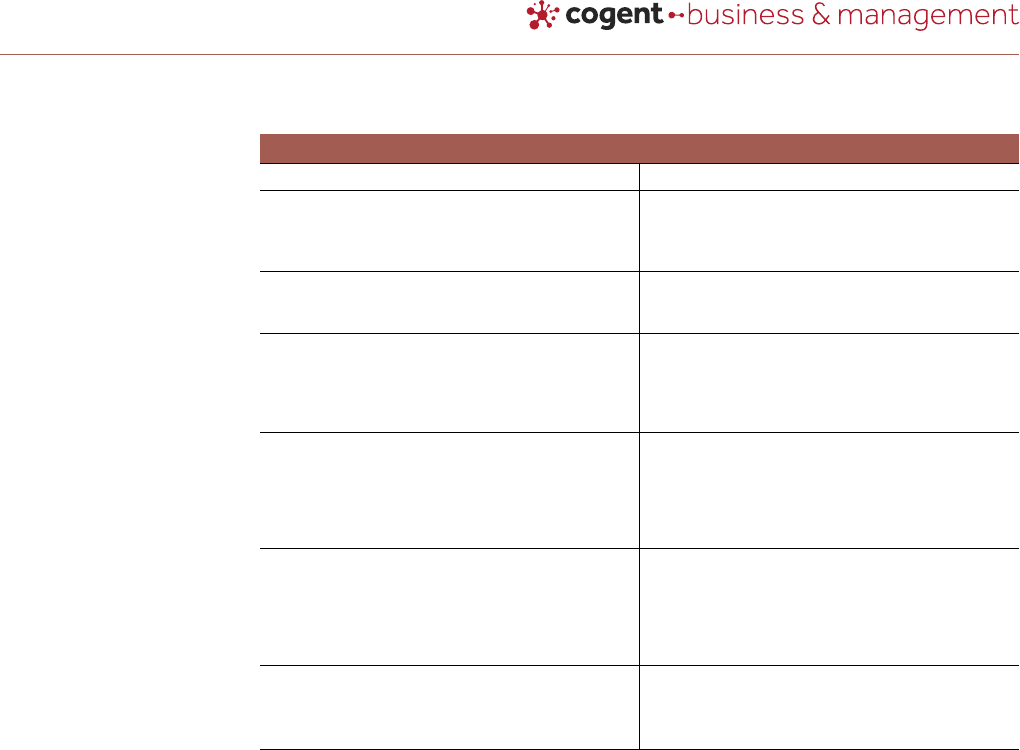
Table A2. Operationalization table of variables
Definition by authors Interviewees feedback
Quality of Information refers to the quality video
provided the content or information in the Facebook
mid-roll video advertisements (FMVAs) (Hsin Chang
et al., 2013; Yang et al., 2017).
Brand, Content, Key message, Storyline, Place to get,
Product, Price, Description, Up-to-date information,
Appropriate length of ads time
Credibility defines as how the Facebook mid-roll
video advertisements (FMVAs) can be believed/trusted
or not (Prendergast et al., 2009; Yang et al., 2017).
Truth, Sincerity, Honesty
Perceived Intrusiveness refers to being negatively
interrupted by the Facebook mid-roll video
advertisements (FMVAs) while viewing or watching
the video on Facebook (Hsin Chang et al., 2013;
Prendergast et al., 2009; Yang et al., 2017).
Hard sell (feel forced), Waste my time, threaten
privacy, Not related (congruence) like watch football
video but the female apparel product ads show,
Interrupt the original video content (Annoying)
FMVAs Attitude refers to customers’ beliefs and/or
opinions to the Facebook mid-roll video
advertisements (FMVAs), which can be whether
positive or negative after experienced with or have
watched, seen, viewed, heard (E.-B. E.-B. Lee et al.,
2017; Y.-G. Y.-G. Lee et al., 2016).
Smart, mid-roll advertising
WOM Intention means the customers’ desire to
express and share their thinking as well as attitudes
about the related FMVA’s topics (FMVA’s itself, product
or services from advertisers, content) to others
(Mukherjee & Banerjee, 2017; Ranaweera &
Karjaluoto, 2017).
Positive and negative points of view
FMVAs Viewers’ Response once users have watched
the Facebook Mid-roll Video Advertisements (FMVAs),
they will react or respond to their actual behaviors to
the FMVAs (Hsin Chang et al., 2013).
Watch, product/service on mid-roll ads
Thavorn et al., Cogent Business & Management (2022), 9: 2062091
https://doi.org/10.1080/23311975.2022.2062091
Page 21 of 22

© 2022 The Author(s). This open access article is distributed under a Creative Commons Attribution (CC-BY) 4.0 license.
You are free to:
Share — copy and redistribute the material in any medium or format.
Adapt — remix, transform, and build upon the material for any purpose, even commercially.
The licensor cannot revoke these freedoms as long as you follow the license terms.
Under the following terms:
Attribution — You must give appropriate credit, provide a link to the license, and indicate if changes were made.
You may do so in any reasonable manner, but not in any way that suggests the licensor endorses you or your use.
No additional restrictions
You may not apply legal terms or technological measures that legally restrict others from doing anything the license permits.
Cogent Business & Management (ISSN: 2331-1975) is published by Cogent OA, part of Taylor & Francis Group.
Publishing with Cogent OA ensures:
• Immediate, universal access to your article on publication
• High visibility and discoverability via the Cogent OA website as well as Taylor & Francis Online
• Download and citation statistics for your article
• Rapid online publication
• Input from, and dialog with, expert editors and editorial boards
• Retention of full copyright of your article
• Guaranteed legacy preservation of your article
• Discounts and waivers for authors in developing regions
Submit your manuscript to a Cogent OA journal at www.CogentOA.com
Thavorn et al., Cogent Business & Management (2022), 9: 2062091
https://doi.org/10.1080/23311975.2022.2062091
Page 22 of 22
